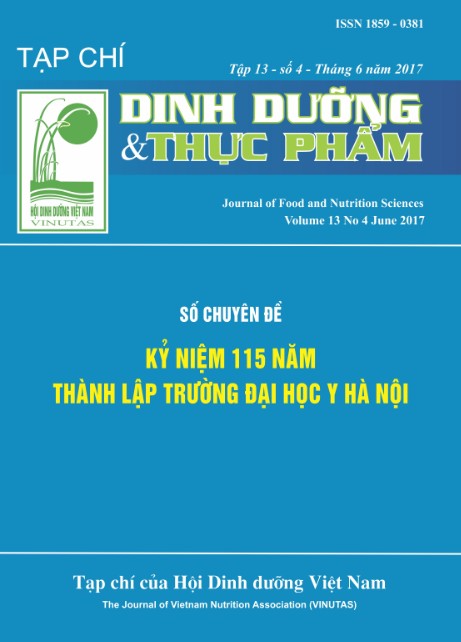TÌNH TRẠNG DINH DƯỠNG CỦA BỆNH NHÂN ĐÁI THÁO ĐƯỜNG TÝP 2 VÀ MỘT SỐ YẾU TỐ LIÊN QUAN TẠI KHOA NỘI BỆNH VIỆN ĐẠI HỌC Y HÀ NỘI NĂM 2016
Main Article Content
Abstract
Diabetes type II is a chronic illness which related to nutrition and lifestyle which is increasing rapidly all over the world. Objective: To assess the nutritional status and some relevant factors among diabetes type II patients at Hanoi Medical University Hospital. Methods: A cross-sectional study was conducted in 200 patients. A structured questionnaire and anthropometric measurements were used to collect data. Results: According to Body Mass Index (BMI), the rate of overweight/obesity (BMI ≥ 25 kg/m2) was 16.5% and the proportion of malnutrition (BMI <18.5 kg/m2) was 8.5%. 56 % of the participants have inadequate energy intake. The results of the research has identified a relationship between overweight and obesity with some relevant of factors such as lack of exercise had 2.4 times (p< 0.05) higher risk of overweight and obesity excessive energy intake had 4.4 times (p< 0.05) higher risk of overweight and obesity unreasonable diet had 5 times (p< 0.05 higher risk of overweight and obesity).
Keywords
Nutritional status, type 2 diabetes, Hanoi Medical University Hospital
Article Details
References
2. Trần Hữu Dũng, Nguyễn Hải Thủy (2013). Tổng quan về vai trò tinh bột đề kháng trong kiểm soát đường huyết sau ăn trên bệnh nhân đái tháo đường týp 2. Tạp chí Y Dược học. Tập. 53. Số 7. Trang 6-12.
3. Campanini B. (2002). The World Health report 2002, In Reducing Risks, Promoting Healthy Life. World Health Organization.
4. Franz M.J, Boucher J.L and Evert A.B (2014). Evidence-based diabetes nutrition
therapy recommendations are effective: the key is individualization. Diabetes Metab Syndr Obes, 65-72
5. Choo V (2002). WHO reassesses appropriate body-mass index for Asians populations. Journal of the Lancet, 360(9328),325.
6. Bộ Y Tế (2015). Hướng dẫn điều trị dinh dưỡng lâm sàng. NXB Y học. Tr 128 -132.
7. Đỗ Thị Ngọc Diệp, Phan Nguyễn Thanh Bình (2014). Dịch tễ học bệnh đái tháo đường tại TP HCM và một số yếu tố liên quan. Tạp chí Dinh dưỡng và Thực phẩm. Tập 10. Số 4. Tr 9 – 10.
8. Đỗ Thái Hòa, Trương Việt Dũng (2014). Tỷ lệ hiện mắc tăng huyết áp, tăng đường huyết và một số yếu tố liên quan ở nhóm tuổi trung niên tại huyện Đông Sơn, Thanh Hoá, năm 2013. Tạp chí Y học dự phòng. Tập XXIV. Số 8. Tr 30.
9. Đinh Thị Kim Liên (2002). Đánh giá tình hình dinh dưỡng của bệnh nhân ĐTĐ đến khám và điều trị tại bệnh viện Bạch Mai. Công trình nghiên cứu khoa học Bệnh viện Bạch Mai 2003- 2004. Tập 1. NXB Y học. tr 203-212.


